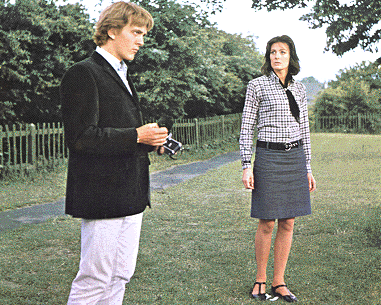Blow-up is clearly
a very significant film. It is clearly a pretty superb film. It is also a
rather tedious and often ridiculous film. It is the proof that a movie doesn’t
have to be simply good or bad but can be an infuriating mixture of the two.
Take, for instance, the famous photo-shoot scene near the
beginning of the film, which is an amazing piece of cinema. Nothing happens,
but the sexual energy is tangible, generated by a combination of the stunning
model (Veruschka von Lehndorff) in a beautiful dress writhing on the floor, and
David Hemmings’ shouting of commands and delighting in their success. It is
Hemmings’ quiet control which also hangs over that scene as it does the whole
film, that being the key ingredient to the brilliance of his performance, and,
indeed, his sex appeal which became abundant upon the film’s release. The whole
thing is breathtaking.
That isn’t the start of the film however. The start is a
really curious incident involving a rampaging van of mime artists who, without
a trace of irony, are screaming and shouting. What the hell is up with these
people? They don’t seem terribly important to the film at all, though others do
disagree, focussing on the van’s equally bizarre (and in my opinion equally
irrelevant) appearance at the end of the film. The mime artists are symptomatic
of a self-indulgent absurdity which drags the film down, and which is
reminiscent of the worst excesses of Fellini, though in a mercifully smaller
dose.
The story takes place over the course of about 24 hours.
Thomas (Hemmings) is a photographer who is putting together a new book. In his
search for the final shot, he shoots two lovers in a park without their
knowledge. When one of them, Jane (Vanessa Redgrave), notices him, she rushes
over in a panic to get the photos back and pursues Thomas throughout the day in
order to obtain them. However, when he begins to examine the shots, Thomas
realises he may have captured more on film than he thought.
Though that is the main thrust of the plot, it takes up a
remarkably small amount of the film’s 111 minutes. Over the rest of it, there
are trips to antique shops, the first use of full frontal nudity in a British
film, Peter Bowles feigning drug abuse (utterly unconvincingly), and an
impromptu gig by The Yardbirds. Some of this is interesting. Some of this has
that same ineffable brilliance that the aforementioned photo-shoot has. However,
an awful lot of it is just an exercise in tedium.
As a piece of Britain in the sixties it is of interest. In
terms of the taboos it broke, it merits to be called important, and there is
more. The frank and full frontal depiction of sex in the film is not
gratuitous, though it does push the boundaries there, and there is also a sense
in certain moments of this being a film
from and for the revolutionary generation of whom my generation have
heard so much about, and, as such, it carries a somewhat effervescent energy
and a sense of this being of almost documental status.
Yet, despite the excellence of the performances (Redgrave deserves a name check), the effective feel of the film and the absolute brilliance of some scenes, this drags on far too long, does far too little with its time and concludes in an unsatisfactory and positively loopy manner. Its relevance has decreased with time and will continue to do so. With all of this wrong with it, thank God for David Hemmings.



No comments:
Post a Comment